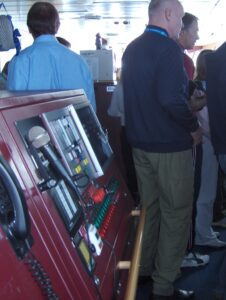» posted on Wednesday, December 23rd, 2020 by Linda Lou Burton
From the Bridge
Christmas in Antarctica originally posted by Linda Lou Burton December 23, 2005 from Drake Passage, Antarctica – We entered the Southern Ocean a few hours ago. AKA the Convergence Zone. The Drake Passage is the Drake Lake today. Sometimes, I’m told, it is the Drake Shake. When that happens, you pay your Drake Tax. I’m wearing my acupressure wristbands to avoid seasickness, even though the roll is gentle. Like the man waving the stick to keep the elephants away, it’s working!
Since there is nothing to look at today but water, water, everywhere, our leader has planned events to keep us busy. Morning, a trip to the Bridge. Then, lectures.
- Penguins: The brush-tailed – Life and Death Part II, by Dr Manuel Marin
- The Antarctic Frigid Zone – Why is it so?, by Alan Parker
- Heroic Hearts: Amundsen and Scott, by Ian Shaw
And of course, our Pre-landing briefing at 6 PM.
The Happy Hour drink today is Planter’s Punch, and the phrase of the day is “Are you cold? Er du kald? Ist Dir kalt? Tienes frio?”
I want to hear Alan Parker’s lecture today. Alan has made 56 trips to Antarctica, been awarded a Polar Medal for his contributions to science in Antarctica, and even has a mountain named for him! Parker Peak. A native of Australia, he has lived on Macquarrie Island for a 12-month stint, and worked at Davis Station for fifteen. Who better to listen to for learning more about Antarctica?
 But about the water now: according to my handout, the Antarctic Convergence is where the warmer waters of the north meet the colder, denser, less saline waters of the south. Colder water sinks, of course, causing an up-welling that brings nutrients to the surface. This point, which is ever-changing, is the biological limit of the Antarctic ecosystem. There is no way to know when you cross it except by thermometer. But, I am assured by the second-in-command on the Bridge, we have passed it now. Our Captain is busy shaking hands, greeting visitors, smiling at us all.
But about the water now: according to my handout, the Antarctic Convergence is where the warmer waters of the north meet the colder, denser, less saline waters of the south. Colder water sinks, of course, causing an up-welling that brings nutrients to the surface. This point, which is ever-changing, is the biological limit of the Antarctic ecosystem. There is no way to know when you cross it except by thermometer. But, I am assured by the second-in-command on the Bridge, we have passed it now. Our Captain is busy shaking hands, greeting visitors, smiling at us all.
More facts. The Convergence Zone, this Polar Front, is a function of the Antarctic Circumpolar Current. The waters of Antarctica circle the continent in the world’s biggest ocean current at an estimated rate of 150 million cubic meters per second! That’s  equivalent to FOUR GULF STREAMS or ONE THOUSAND AMAZON RIVERS! As this dense water begins to move north, it has tremendous impact on global weather systems. Carried into the Atlantic and Pacific Oceans, it has a cooling effect on tropical and temperate waters, very important to the oceans’ balance.
equivalent to FOUR GULF STREAMS or ONE THOUSAND AMAZON RIVERS! As this dense water begins to move north, it has tremendous impact on global weather systems. Carried into the Atlantic and Pacific Oceans, it has a cooling effect on tropical and temperate waters, very important to the oceans’ balance.
I’m impressed! “Exactly where is it considered the point where the Atlantic and Pacific meet?” I asked. A shrug. “I don’t know,” was the reply, “perhaps at Cape Horn?”
This is humorous to me. I picture the ship pointed south from Cabos de Hornos, riding a fine dotted line with Atlantic left, Pacific right, then, blip, another hop into Southern Ocean waters.

